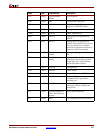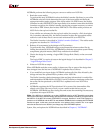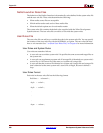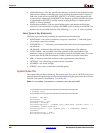
Development System Reference Guide www.xilinx.com 385
NGDBuild
R
NGDBuild performs the following steps to convert a netlist to an NGD file:
1. Reads the source netlist
To perform this step, NGDBuild invokes the Netlist Launcher (Netlister), a part of the
NGDBuild software which determines the type of the input netlist and starts the
appropriate netlist reader program. If the input netlist is in EDIF format, the Netlist
Launcher invokes EDIF2NGD. If the input netlist is in another format that the Netlist
Launcher recognizes, the Netlist Launcher invokes the program necessary to convert
the netlist to EDIF format, then invokes EDIF2NGD. The netlist reader produces an
NGO file for the top-level netlist file.
If any subfiles are referenced in the top-level netlist (for example, a PAL description
file, or another schematic file), the Netlist Launcher invokes the appropriate netlist
reader for each of these files to convert each referenced file to an NGO file.
The Netlist Launcher is described in “Netlist Launcher (Netlister)”. The netlist reader
programs are described in “EDIF2NGD”.
2. Reduces all components in the design to NGD primitives
To perform this step, NGDBuild merges components that reference other files by
finding the referenced NGO files. NGDBuild also finds the appropriate system library
components, physical macros (NMC files) and behavioral models.
3. Checks the design by running a Logical DRC (Design Rule Check) on the converted
design
The Logical DRC is a series of tests on the logical design. It is described in Chapter 5,
“Logical Design Rule Check”.
4. Writes an NGD file as output
When NGDBuild reads the source netlist, it detects any files or parts of the design that
have changed since the last run of NGDBuild. It updates files as follows:
• If you modified your input design, NGDBuild updates all of the files affected by the
change and uses the updated files to produce a new NGD file.
The Netlist Launcher checks timestamps (date and time information) for netlist files
and intermediate NGDBuild files (NGOs). If an NGO file has a timestamp earlier than
the netlist file that produced it, the NGO file is updated and a new NGD file is
produced.
• NGDBuild completes the NGD production if all or some of the intermediate files
already exist. These files may exist if you ran a netlist reader before you ran
NGDBuild. NGDBuild uses the existing files and creates the remaining files necessary
to produce the output NGD file.
Note:
If the NGO for an netlist file is up to date, NGDBuild looks for an NCF file with the same base
name as the netlist in the netlist directory and compares the timestamp of the NCF file against that of
the NGO file. If the NCF file is newer, EDIF2NGD is run again. However, if an NCF file existed on a
previous run of NGDBuild and the NCF file was deleted, NGDBuild does not detect that EDIF2NGD
must be run again. In this case, you must use the –nt on option to force a rebuild. The –nt on option
must also be used to force a rebuild if you change any of the EDIF2NGD options.
Syntax, files, and options for NGDBuild are described in Chapter 6, “NGDBuild”.


















